Guide
Speed & Performance
Sierra Chart stands out as a powerful trading platform, known for its exceptional performance and comprehensive feature set. When configured correctly, it’s among the fastest and most reliable charting software out there. However, like any software, its performance can be influenced by a variety of factors, including system resources, settings, and network conditions.
This guide aims to offer additional practical steps to further optimize Sierra Chart alongside our templates, ensuring a seamless, high-performance trading experience.
SSD Usage for Enhanced Performance
We highly recommend running Sierra Chart on a Solid State Drive (SSD) to significantly boost its performance. SSDs offer faster read/write speeds compared to traditional Hard Disk Drives (HDDs), ensuring quick data loading and chart rendering. This becomes particularly important when dealing with large data sets or high-frequency trading scenarios.
- Store Sierra Chart and its data files on an SSD.
Leveraging OpenGL
Activating OpenGL is another crucial step that can lead to immediate performance improvements. Enabling OpenGL in Sierra Chart essentially allows for hardware-accelerated graphics output, resulting in smoother chart movements and faster rendering, especially when dealing with complex chart setups with multiple studies and overlays.
- Navigate to
Global Settings > Graphics Settings > Other. - Check
Use OpenGL for Chart Graphics.
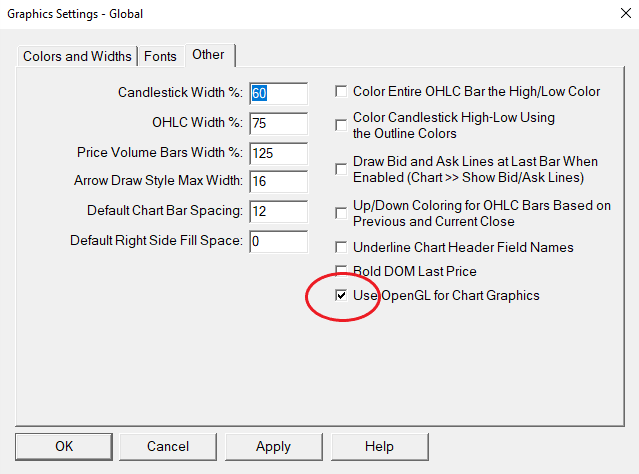
- If you encounter any issues, you can disable OpenGL and restart Sierra Chart.
Optimize Resource Management with Sub-Instances
When you find yourself dealing with numerous charts and studies within a single Sierra Chart instance, you may encounter a decrease in overall responsiveness. To enhance your workflow and resource management, consider using sub-instances. Each sub-instance operates independently, allowing you to tailor it for specific tasks or data sets. This approach can significantly improve the performance of your Sierra Chart setup, particularly on multi-core systems, where each instance can utilize a separate core.
A common strategy is to dedicate one instance to resource-intensive data processing studies (e.g., Higher Time Frame Analysis) while maintaining a separate sub-instance for your execution charts (e.g., Lower Time Frame Charts like Scalping or DOM). This configuration ensures that your trades on execution charts fire swiftly and without delays.
- Go to
File > New Instanceto create a sub-instance. - Customize each instance as needed.
- Open instances on startup: Navigate to
Global Settings > General Settings.
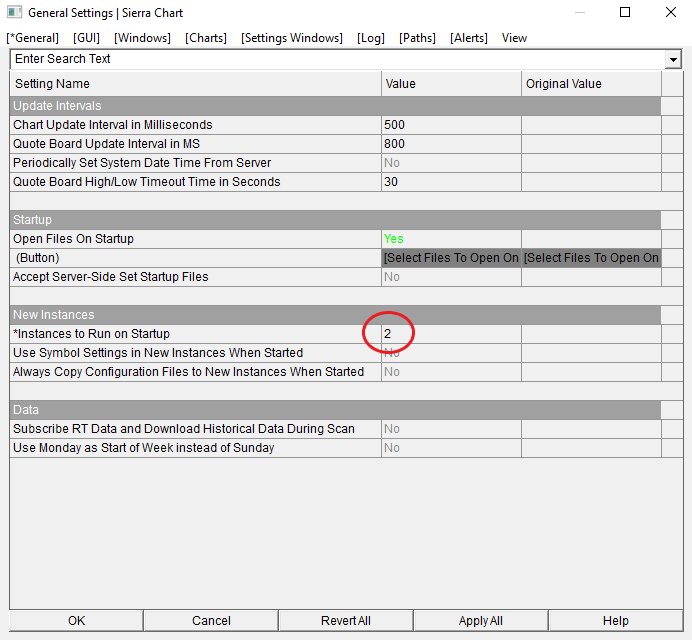
Adjust Chart Update Intervals
The chart update interval determines how often Sierra Chart refreshes the chart display. Reducing the frequency of updates can result in better performance. Ideally, you should do this for your resource-intensive charts to minimize CPU load. Consider setting it to around 500 ms or even higher. For your execution chart(s), we recommend setting this to as low as 20-50 ms to guarantee very fast responsiveness. You can set this parameter in Global Settings for all charts within an instance, or you can override Global Settings by navigating to Chart Settings and setting the parameter for a single chart.
- Navigate to
Global Settings > General Settings. - Set a value for
Chart Update Interval in Milliseconds.
or
- Click on your Chart and go to
Chart > Chart Settings > Display - Set a value for
Chart Update Interval in Milliseconds.
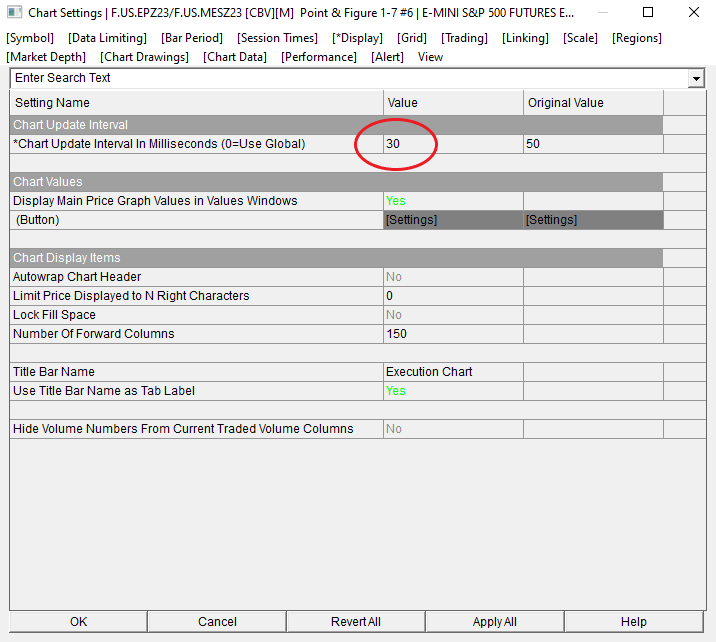
Limiting Days to Load
Limiting the number of days to load for historical data can conserve system resources and improve chart loading times. This is particularly useful in scenarios where long-term historical data is not required.
- Right-click on a
Chart > Chart Settings. - Adjust
Days to Loadaccording to your needs.
Adjusting Tick Size in Volume Profiles
If you have numerous Volume Profiles loaded, you may experience slower charts. Sierra Chart calculates data for every Tick Size set in the Volume Profile Settings, resulting in increased CPU load. Increasing the Tick Size can enhance performance and responsiveness, especially for Higher Time Frame Charts where precise 1 Tick data may not be necessary.
- Right-click on a
Chart > Studies. Select yourVolume Profile Study > Settings
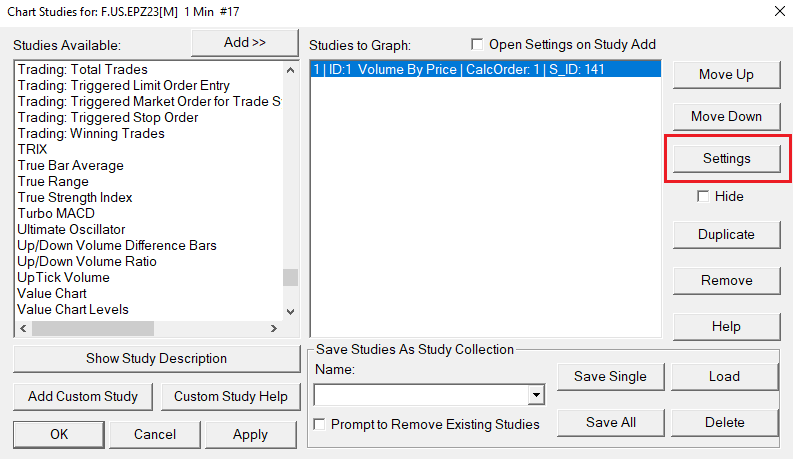
- Adjust to a higher Tick Size.
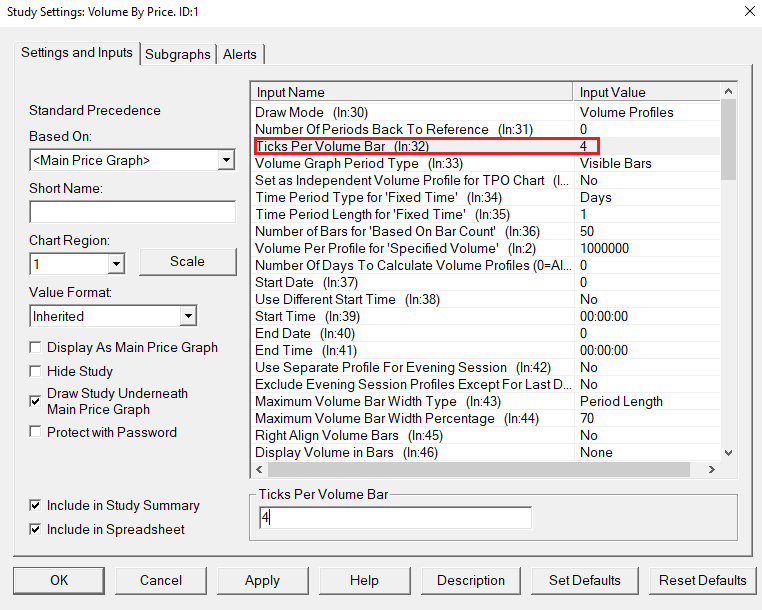
Efficient Studies Selection
Selecting efficient studies and avoiding overly complex or multiple studies running simultaneously can reduce the computational load on Sierra Chart. Opt for studies that provide the information you need without overloading your system.
Note: All our preconfigured templates are optimized for maximum efficiency and performance.
